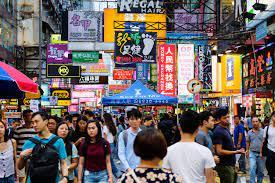In recent decades, China has firmly established itself as the largest economy on the planet and the "factory of the world." The country, which in the second half of the last century (quite recently in terms of history) experienced a deep and systemic economic crisis, now occupies leading positions in a number of key spheres.
Thus, China's GDP, according to the IMF in 2023, amounted to 17,8 trillion dollars. The World Bank's estimates are even higher — 19,3 trillion dollars.
All of this has made the PRC the second-largest economy in the world after the United States in nominal terms and the first in terms of purchasing power parity (PPP). China's total share of global GDP has exceeded 18%, and this figure continues to grow steadily.
China has also become the largest trading partner for more than 120 countries and associations, including the European Union, the United States, and many countries in Asia and Africa. The volume of foreign direct investment in the Chinese economy in 2022 reached 189 billion dollars, indicating the country's high attractiveness to international business. Entering the Chinese market guarantees good margins and stable profits.
China continues to hold its status as the world leader in goods and services exports. The volume of Chinese exports in 2023 exceeded 3,6 trillion dollars. This is a few percent lower than in 2022, but still very large numbers.
However, China's success did not arise suddenly out of nowhere. This economic giant has undergone decades of complex systemic transformations, beginning with the reforms initiated in 1978 by the PRC’s leader Deng Xiaoping and extending to significant changes in the global economy, which have led to its current status. To better understand this process, it is necessary to examine the stages of China's economic growth, its key sectors, and the reforms that laid the foundation for the country's current economic power.
Economic Development of China from 1986 to the Present
The successes of China's economic transformation became evident to the global community in the mid-1980s when the country began to demonstrate impressive growth. That is why in this article, we will start from 1986, when gross domestic product indicators began to rise sharply and noticeably.
GDP per capita in 1986 was about 300 dollars, reflecting a relatively low level of economic development. By the end of 2022, this figure had risen to 12,700 dollars – more than 42 times higher. This reflects the multiple increases in the population's income and the deep diversification of the country's economy.
To simplify our analysis, let us examine the structure of China's economic model using examples of its main sectors. This will help us systematize the research and make it more illustrative.
-
Industry and Technology. The development of Chinese industry became one of the key factors in the PRC’s growth, particularly in sectors such as electronics manufacturing, textile industry, and mechanical engineering. In particular, information technology and electronics sector, which began actively growing in the 1990s, eventually became the driving force of the national economy. Companies like Huawei, Xiaomi, and Lenovo have entered the global stage, becoming fully-fledged multinational corporations and securing China’s status as a leading technological power.
-
Agriculture also played a key role in the country's economic development, especially in the early stages of systemic transformations. In the 1980s, agrarian reforms initiated by Deng Xiaoping ensured increased food production and reduced poverty levels in rural areas. Over time, agriculture’s share of China's GDP declined, giving way to industry and services, but its importance for the country's food security remains crucial. Today, the PRC possesses the largest agricultural sector in the world, with its share in the country's total GDP amounting to 7-10%. China now accounts for 25% of all global food production.
-
Investment and Infrastructure. Massive investments in infrastructure starting in the 1990s have allowed China to create one of the most developed transport and energy systems in the world. The country has built thousands of kilometers of high-speed railroads, highways, and ports, making the PRC one of the hubs of global logistics and the main logistics hub of Asia. 18 nuclear power plants with 54 reactors produce more than 50 GW of energy, making China an energy-independent state. In 2021 alone, infrastructure investments amounted to about 5 trillion yuan (around 775 billion dollars).
-
Services and Financial Sector. Over the past two decades, there has been rapid growth in the service sector, including finance, trade, education, and healthcare. The GDP of the services sector, which in the 1990s amounted to no more than 30% of the total, exceeded 55% by 2023. Beijing has become a global financial center, and the Shanghai Stock Exchange — one of the largest in the world.
Key sectors of China’s economy — from agriculture to industry, from services to high technologies — have demonstrated double-digit growth rates, contributing to China’s transformation into one of the leading players on the global economic stage.
The Role of Deng Xiaoping’s Reforms in China's Economic Transformation
No successful state became such by chance. Every success is preceded by years of painstaking and systematic work, especially if the task is to turn an underdeveloped agrarian country into a powerful post-industrial giant.
One of the most important factors in the PRC’s transformation was the reforms initiated by the then Chinese leader Deng Xiaoping in the late 1970s and early 1980s. His policies drastically changed China’s economic and partially political system, moving the country from a centrally planned economy to a mixed model that combines market mechanisms with elements of capitalism under state control. So, what were Deng's main focuses?
-
Agrarian Reform. One of the first steps was introducing the system of family contract responsibility in Chinese villages. Deng Xiaoping allowed Chinese farmers to sign contracts to rent land from the state and earn profits from selling their produce in the market. This led to a significant increase in agricultural production and the incomes of peasants, becoming an important step in the fight against poverty and food shortages, which severely affected the country at that time.
-
Creation of Special Economic Zones (SEZ). In the 1980s, the first special economic zones were created in coastal areas such as Shenzhen, Shantou, Zhuhai, and Xiamen. These zones provided preferential regimes for foreign investors, contributing to the inflow of capital and the development of export-oriented industries. A textbook example of the success of China’s SEZs is Shenzhen, which was once a small fishing village. Within a few decades, it transformed into one of the largest industrial centers in the world with a population of over 17 million. The city's rapid development continues to this day.
-
Industrial Reforms. An important step was the reform of state enterprises, many of which shifted to market principles, albeit with a Chinese national specificity. This transition from a planned economy to a more flexible management system improved production efficiency and productivity. The private sector gradually began to play an increasingly important role in the country's economy, especially in areas such as light industry, services, and trade.
-
Openness to the World. One of Deng Xiaoping’s key focuses was his course toward external openness. China began actively attracting foreign investment, signing international trade agreements, and integrating into the global economy at record speed. China’s entry into the WTO in 2001 was a significant milestone on this path, securing its position as a global player in the world trade system.
The Current State of China's Economy: Achievements and Challenges
Today, China is a powerful and fairly stable economy fully integrated into global trade. GDP growth rates in 2023 reached 5.2%. This is lower than in 2021 (which was 8.4%) but higher than in 2022, when the figure stood at 3%.
These figures indicate the stability of economic development even in the face of global challenges, such as the COVID-19 pandemic, which originated in China and caused significant financial damage, or trade conflicts with the United States. However, alongside its successes, the Chinese economy faces a number of problems. Its future financial well-being depends on understanding and addressing these challenges.
-
Dependence on Exports. Despite successes in diversifying its national economy, China remains highly dependent on the export of goods, particularly to the United States, with whom Beijing is in geopolitical opposition. More than 30% of the country’s GDP comes from foreign trade, making the economy vulnerable to global economic shocks and changes in global trade policy.
-
High Levels of Government Debt. In recent years, China’s government debt has risen significantly. The situation with local government debts is particularly concerning and could become a source of financial instability in the future. As of the end of 2023, China’s national debt was estimated at around 77% of GDP, which corresponds to 12-13 trillion dollars. At the same time, it is important to note that most of this debt is domestic (denominated in yuan), while China’s external debt by March 2024 will stand at 2,5 trillion dollars, which is also significant, though not critical.
-
Social Inequality and Over-urbanization. Rapid economic growth has led to a significant improvement in living standards in cities, but at the same time, it has exacerbated social inequality, particularly between urban and rural areas. The scale of urbanization also creates problems with overpopulation in cities (in some Chinese megacities, over 30 million people live), leading to environmental challenges.
-
Environmental Problems. The explosive growth of industrial production and the rapid development of urban infrastructure have led to serious environmental issues, such as severe air, soil, and water pollution. However, in recent years, China has launched an active campaign to reduce carbon emissions. The government aims to transition to renewable energy sources, but solving environmental problems requires time and significant investments. Currently, this process is far from complete.
Thus, we can conclude that China’s economic transformation is a unique historical process, the experience of which is of great interest to experts worldwide. It has changed not only the destiny of the country but also the global economic landscape of both the Asian region and the entire world.
Thanks to the systemic reforms of Deng Xiaoping and the policies of subsequent national governments, China has transformed from a low-income agrarian country into the largest industrial and trading superpower. Despite existing challenges, such as dependence on exports, severe environmental issues, and social inequality, China continues to play a very important role in the global economy.
The country demonstrates stable growth and development and does not intend to stop at its already achieved successes. For example, in 2013, current Chinese President Xi Jinping proposed the "One Belt, One Road" concept. This is a global economic strategy aimed at forming new models of interregional trade cooperation with China’s active participation. In fact, today Beijing is promoting its own globalization project, but unlike the West, it focuses on economic rather than political tools.
The example of the People’s Republic of China demonstrates how targeted economic reforms, support for the private sector, and integration into the global economy can lead to rapid and dynamic growth. However, the challenges facing China emphasize the need to continue structural reforms and find ways for sustainable development in the rapidly changing global order.
When studying China’s economic success, experts should also not forget about the national and cultural characteristics of this country, which means that not all of China’s experience may be relevant for application in other developing countries.
Author – Mykyta Trachuk, political scientist, expert at the "Ukrainian Institute of Politics."


